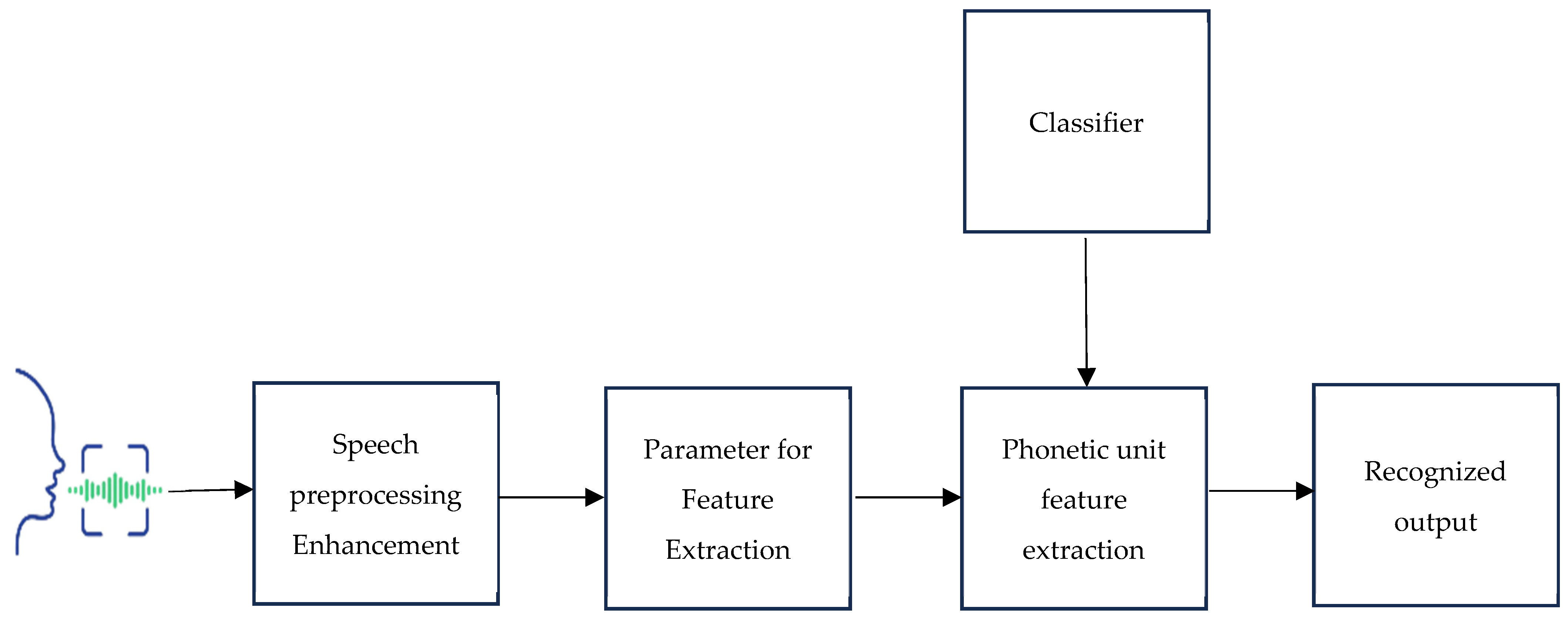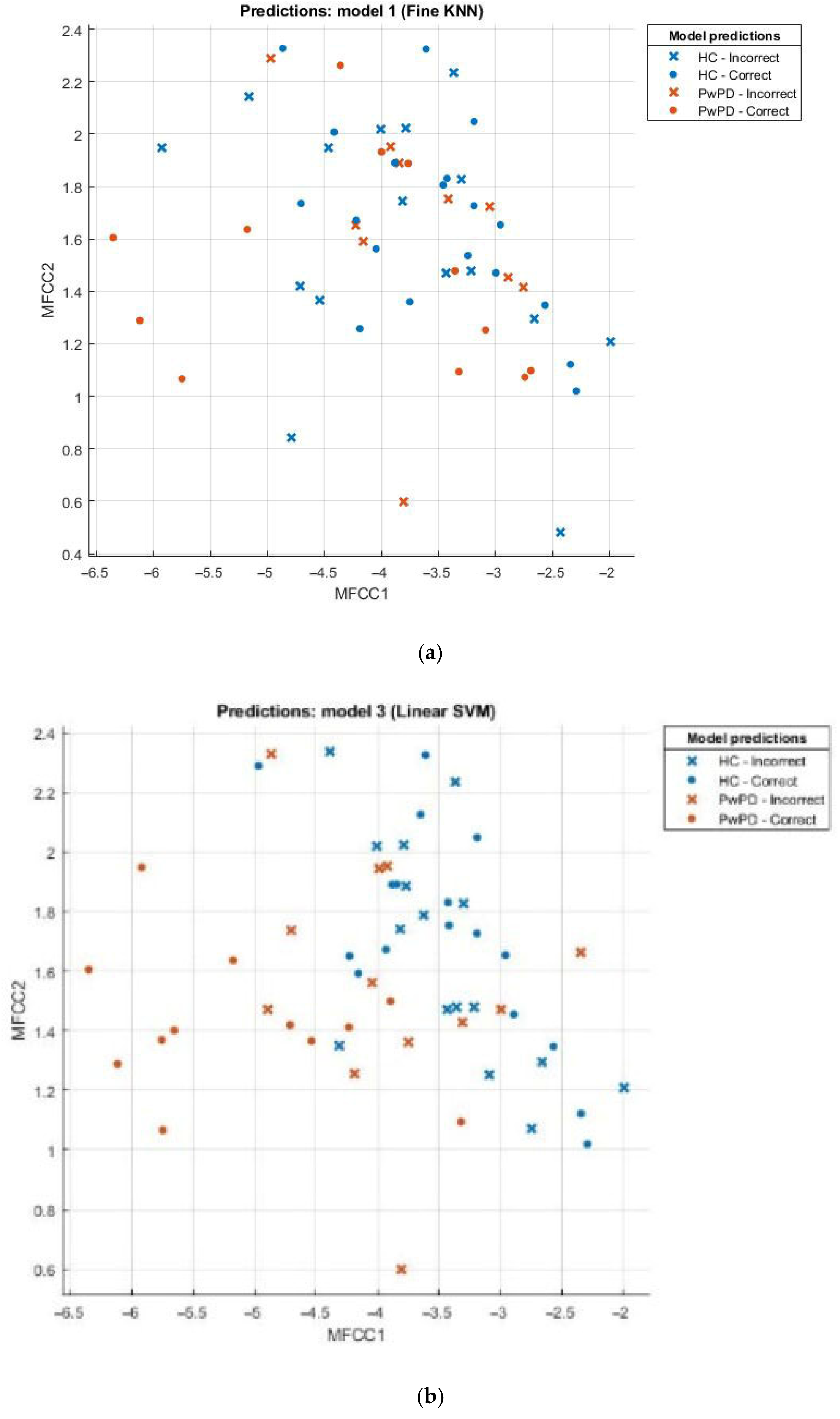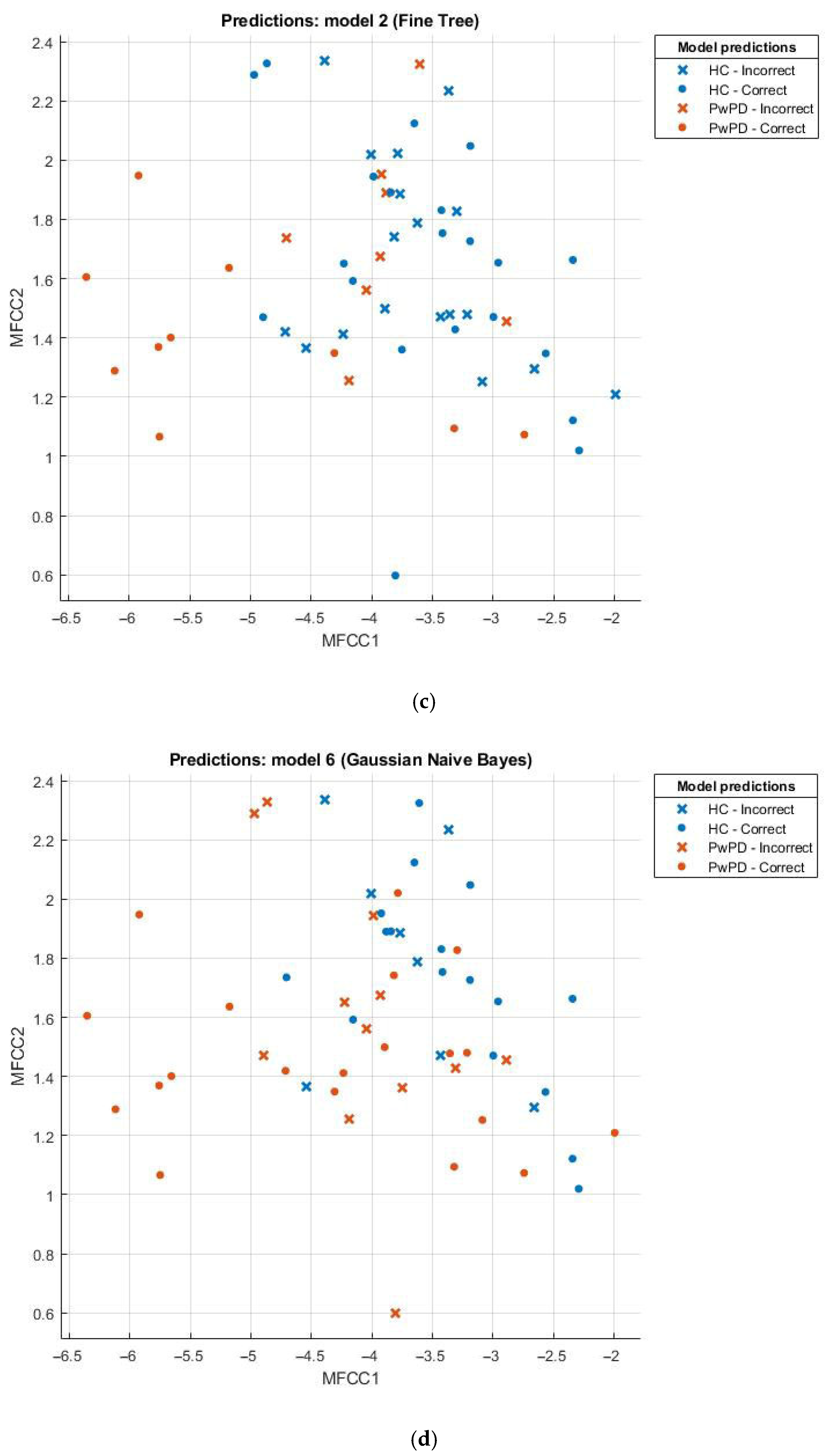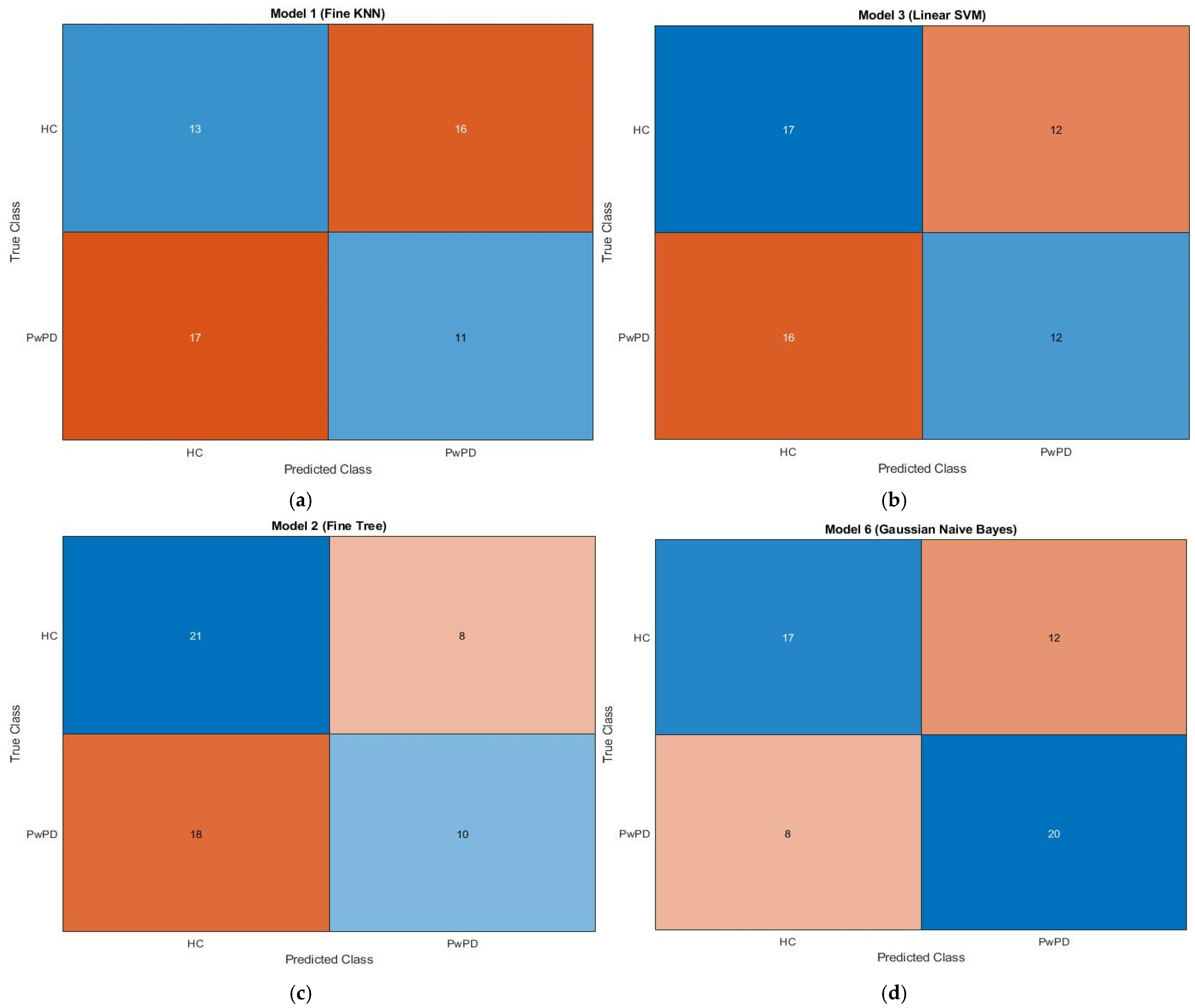Implementation of a Prototype-Based Parkinson’s Disease Detection System Using a RISC-V Processor †
Abstract
1. Introduction
2. Methodology
2.1. Data Set
2.2. Proposed Flow Diagram
2.2.1. Preprocessing
2.2.2. Machine Learning Models
2.3. Experiments
2.4. Performance Metrics
3. Results and Discussion
3.1. Classification Report Summary
3.2. Evaluation of Model Performance Using Scatter Plot
3.3. Confusion Matrix Insights
4. Conclusions
Author Contributions
Funding
Institutional Review Board Statement
Informed Consent Statement
Data Availability Statement
Conflicts of Interest
References
- Dharavathu, K.; Mosa, S.A. Efficient Transmission of an Encrypted Image Through a MIMO–OFDM System with Different Encryption Schemes. Sens. Imaging 2020, 21, 13. [Google Scholar] [CrossRef]
- Dharavathu, K.; Mosa, A. Secure image transmission through crypto-OFDM system using Rubik’s cube algorithm over an AWGN channel. Int. J. Commun. Syst. 2020, 33, e4369. [Google Scholar] [CrossRef]
- Chen, Y.-H.; Chen, S.-W.; Jian, H.-W.; Lin, S.-Y.; Chen, R.-S. A Very Large-Scale Integration (VLSI) Chip Design for Abnormal Heartbeat Detection Using a Data-Shifting Neural Network (DSNN). IEEE Access 2024, 12, 14005–14013. [Google Scholar] [CrossRef]
- Bhattacharya, I.; Bhatia, M.P.S. SVM classification to distinguish Parkinson disease patients. In Proceedings of the 1st Amrita ACM-W Celebration on Women in Computing in India (A2CWiC ‘10). Association for Computing Machinery, Coimbatoire, India, 16–17 September 2010. [Google Scholar] [CrossRef]
- Almeida, J.S.; Rebouças Filho, P.P.; Carneiro, T.; Wei, W.; Damaševičius, R.; Maskeliūnas, R.; De Albuquerque, V.H.C. Detecting Parkinson’s Disease with Sustained Phonation and Speech Signals Using Machine Learning Techniques. Pattern Recognit. Lett. 2019, 125, 55–62. [Google Scholar] [CrossRef]
- Wroge, T.J.; Ozkanca, Y.; Demiroglu, C.; Si, D.; Atkins, D.C.; Ghomi, R.H. Parkinson’s Disease Diagnosis Using Machine Learning and Voice. In Proceedings of the 2018 IEEE Signal Processing in Medicine and Biology Symposium (SPMB), Philadelphia, PA, USA, 1 December 2018; IEEE: Piscataway, NJ, USA, 2018; pp. 1–7. [Google Scholar]
- Skaramagkas, V.; Pentari, A.; Kefalopoulou, Z.; Tsiknakis, M. Multi-Modal Deep Learning Diagnosis of Parkinson’s Disease—A Systematic Review. IEEE Trans. Neural Syst. Rehabil. Eng. 2023, 31, 2399–2423. [Google Scholar] [CrossRef] [PubMed]
- Drotar, P.; Mekyska, J.; Smekal, Z.; Rektorova, I.; Masarova, L.; Faundez-Zanuy, M. Contribution of Different Handwriting Modalities to Differential Diagnosis of Parkinson’s Disease. In Proceedings of the 2015 IEEE International Symposium on Medical Measurements and Applications (MeMeA) Proceedings, Turin, Italy, 7–9 May 2015; IEEE: Piscataway, NJ, USA, 2015; pp. 344–348. [Google Scholar]
- Shahbakhi, M.; Far, D.T.; Tahami, E. Speech Analysis for Diagnosis of Parkinson’s Disease Using Genetic Algorithm and Support Vector Machine. JBiSE 2014, 7, 147–156. [Google Scholar] [CrossRef]
- New Sensor and Wearable Technologies to Aid in the Diagnosis and Treatment Monitoring of Parkinson’s Disease Annual Reviews. Available online: https://www.annualreviews.org/content/journals/10.1146/annurev-bioeng-062117-121036 (accessed on 25 January 2025).
- Sakar, C.O.; Serbes, G.; Gunduz, A.; Tunc, H.C.; Nizam, H.; Sakar, B.E.; Tutuncu, M.; Aydin, T.; Isenkul, M.E.; Apaydin, H. A Comparative Analysis of Speech Signal Processing Algorithms for Parkinson’s Disease Classification and the Use of the Tunable Q-Factor Wavelet Transform. Appl. Soft Comput. 2019, 74, 255–263. [Google Scholar] [CrossRef]
- Sekaran, K.; Harshavardhan, A.; Sandhya, N.; Sudha, C.; Nagaraju, G.; Bukya, H.; Sahay, R.; Kalaivani, J. A Self-Operational Convolutional Neural Networks With Convergent Cross-Mapping and Its Application in Parkinson’s Disease Classification. IEEE Access 2024, 12, 83140–83153. [Google Scholar] [CrossRef]
- Kamalakannan, N.; Balamurugan, S.P.S.; Shanmugam, K. A novel approach for the early detection of Parkinson’s disease using EEG signal. Int. J. Electr. Eng. Technol. 2021, 12, 80–95. [Google Scholar] [CrossRef]
- Al-Nefaie, A.H.; Aldhyani, T.H.H.; Koundal, D. Developing System-Based Voice Features for Detecting Parkinson’s Disease Using Machine Learning Algorithms. J. Disabil. Res. 2024, 3, 20240001. [Google Scholar] [CrossRef]
- Raveendran, A.; Patil, V.B.; Selvakumar, D.; Desalphine, V. A RISC-V Instruction Set Processor-Micro-Architecture Design and Analysis. In Proceedings of the 2016 International Conference on VLSI Systems, Architectures, Technology and Applications (VLSI-SATA), Bengaluru, India, 10–12 January 2016; IEEE: Piscataway, NJ, USA, 2016; pp. 1–7. [Google Scholar]
- Gaikwad, S.K.; Gawali, B.W.; Yannawar, P. A Review on Speech Recognition Technique. Int. J. Comput. Appl. 2010, 10, 16–24. [Google Scholar] [CrossRef]
- Rajeswari, S.S.; Nair, M. Prediction of Parkinson’s Disease from Voice Signals Using Machine Learning. J. Pharm. Negat. Results 2022, 13, 2031–2035. [Google Scholar]
- Gómez-Vilda, P.; Mekyska, J.; Ferrández, J.M.; Palacios-Alonso, D.; Gómez-Rodellar, A.; Rodellar-Biarge, V.; Galaz, Z.; Smekal, Z.; Eliasova, I.; Kostalova, M.; et al. Parkinson’s Disease Detection from Speech Articulation Neuromechanics. Front. Neuroinform. 2017, 11, 56. [Google Scholar] [CrossRef] [PubMed]
- Anggraeni, D.; Sanjaya, W.S.M.; Nurasyidiek, M.Y.S.; Munawwaroh, M. The Implementation of Speech Recognition Using Mel-Frequency Cepstrum Coefficients (MFCC) and Support Vector Machine (SVM) Method Based on Python to Control Robot Arm. IOP Conf. Ser. Mater. Sci. Eng. 2018, 288, 012042. [Google Scholar] [CrossRef]
- Mohan, B.J.; Babu N, R. Speech Recognition Using MFCC and DTW. In Proceedings of the 2014 International Conference on Advances in Electrical Engineering (ICAEE), Vellore, India, 9–11 January 2014; IEEE: Piscataway, NJ, USA, 2014; pp. 1–4. [Google Scholar]
- Galaz, Z.; Mzourek, Z.; Mekyska, J.; Smekal, Z.; Kiska, T.; Rektorova, I.; Orozco-Arroyave, J.R.; Daoudi, K. Degree of Parkinson’s Disease Severity Estimation Based on Speech Signal Processing. In Proceedings of the 2016 39th International Conference on Telecommunications and Signal Processing (TSP), Vienna, Austria, 27–29 June 2016; IEEE: Piscataway, NJ, USA, 2016; pp. 503–506. [Google Scholar]
- Pankaj, R.; Sushil, K.; Shweta, R. Speech Recognition using Neural Network. In Proceedings of the International Conference on Advancements in Engineering and Technology, ICAET2015, Incheon, Republic of Korea, 11–13 December 2015; pp. 11–14. [Google Scholar]
- Mistry, D.S.; Kulkarni, A.V. Overview: Speech Recognition Technology, Mel-Frequency Cepstral Coefficients (MFCC), Artificial Neural Network (ANN). Int. J. Eng. Res. 2013, 2, 1994–2002. [Google Scholar]
- Bhan, A.; Kapoor, S.; Gulati, M.; Goyal, A. Early Diagnosis of Parkinson’s Disease in Brain MRI Using Deep Learning Algorithm. In Proceedings of the 2021 Third International Conference on Intelligent Communication Technologies and Virtual Mobile Networks (ICICV), Tirunelveli, India, 4–6 February 2021; IEEE: Piscataway, NJ, USA, 2021; pp. 1467–1470. [Google Scholar]
- Sharma, G.; Martin, J. MATLAB®: A Language for Parallel Computing. Int. J. Parallel Prog. 2009, 37, 3–36. [Google Scholar] [CrossRef]




| Sample ID | Pitch (Hz) | Tremor Intensity | MFCC Feature 1 | Target Label |
|---|---|---|---|---|
| S001 | 203.8 | 0.32 | 12.61 | PD |
| S045 | 198.2 | 0.30 | 13.08 | Normal |
| S087 | 206.5 | 0.35 | 12.25 | PD |
| S131 | 200.3 | 0.31 | 12.77 | Normal |
| S175 | 207.1 | 0.36 | 11.88 | PD |
| Performance Parameter | Obtained Values for (KNN) | Obtained Values for (SVM) | Obtained Values for (Fine Tree) | Obtained Values for (Naïve Bayes) |
|---|---|---|---|---|
| Accuracy | 42.1 | 50.8 | 54.3 | 64.9 |
| Precision | 0.44 | 0.58 | 0.72 | 0.58 |
| Recall | 0.43 | 0.43 | 0.53 | 0.68 |
| F1 score | 0.44 | 0.54 | 0.61 | 0.62 |
| S.No | Metric | KNN | SVM | Fine Tree | Naïve Bayes (59 Samples) | Naïve Bayes (175 Samples) |
|---|---|---|---|---|---|---|
| 1 | Accuracy rate of the test data | 42.1% | 50.8% | 54.3% | 64.9% | 95.23% |
| 2 | Training time | 6.596 s | 8.642 s | 10.462 s | 12.623 s | 18.310 s |
| 3 | Prediction speed | ~390 obs/s | ~370 obs/s | ~360 obs/s | ~340 obs/s | ~320 obs/s |
| 4 | F1 Score | 0.44 | 0.54 | 0.61 | 0.62 | 0.93 |
Disclaimer/Publisher’s Note: The statements, opinions and data contained in all publications are solely those of the individual author(s) and contributor(s) and not of MDPI and/or the editor(s). MDPI and/or the editor(s) disclaim responsibility for any injury to people or property resulting from any ideas, methods, instructions or products referred to in the content. |
© 2025 by the authors. Licensee MDPI, Basel, Switzerland. This article is an open access article distributed under the terms and conditions of the Creative Commons Attribution (CC BY) license (https://creativecommons.org/licenses/by/4.0/).
Share and Cite
Dharavathu, K.; Sankula, P.K.; Vullanki, U.M.; Mohammad, S.K.; Kesapatnapu, S.P.; Shaik, S. Implementation of a Prototype-Based Parkinson’s Disease Detection System Using a RISC-V Processor. Eng. Proc. 2025, 87, 97. https://doi.org/10.3390/engproc2025087097
Dharavathu K, Sankula PK, Vullanki UM, Mohammad SK, Kesapatnapu SP, Shaik S. Implementation of a Prototype-Based Parkinson’s Disease Detection System Using a RISC-V Processor. Engineering Proceedings. 2025; 87(1):97. https://doi.org/10.3390/engproc2025087097
Chicago/Turabian StyleDharavathu, Krishna, Pavan Kumar Sankula, Uma Maheswari Vullanki, Subhan Khan Mohammad, Sai Priya Kesapatnapu, and Sameer Shaik. 2025. "Implementation of a Prototype-Based Parkinson’s Disease Detection System Using a RISC-V Processor" Engineering Proceedings 87, no. 1: 97. https://doi.org/10.3390/engproc2025087097
APA StyleDharavathu, K., Sankula, P. K., Vullanki, U. M., Mohammad, S. K., Kesapatnapu, S. P., & Shaik, S. (2025). Implementation of a Prototype-Based Parkinson’s Disease Detection System Using a RISC-V Processor. Engineering Proceedings, 87(1), 97. https://doi.org/10.3390/engproc2025087097






